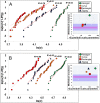Design and Fabrication of 3D printed Scaffolds with a Mechanical Strength Comparable to Cortical Bone to Repair Large Bone Defects
- PMID: 26782020
- PMCID: PMC4726111
- DOI: 10.1038/srep19468
Design and Fabrication of 3D printed Scaffolds with a Mechanical Strength Comparable to Cortical Bone to Repair Large Bone Defects
Abstract
A challenge in regenerating large bone defects under load is to create scaffolds with large and interconnected pores while providing a compressive strength comparable to cortical bone (100-150 MPa). Here we design a novel hexagonal architecture for a glass-ceramic scaffold to fabricate an anisotropic, highly porous three dimensional scaffolds with a compressive strength of 110 MPa. Scaffolds with hexagonal design demonstrated a high fatigue resistance (1,000,000 cycles at 1-10 MPa compressive cyclic load), failure reliability and flexural strength (30 MPa) compared with those for conventional architecture. The obtained strength is 150 times greater than values reported for polymeric and composite scaffolds and 5 times greater than reported values for ceramic and glass scaffolds at similar porosity. These scaffolds open avenues for treatment of load bearing bone defects in orthopaedic, dental and maxillofacial applications.
Figures




Similar articles
-
Fracture behaviors of ceramic tissue scaffolds for load bearing applications.Sci Rep. 2016 Jul 12;6:28816. doi: 10.1038/srep28816. Sci Rep. 2016. PMID: 27403936 Free PMC article.
-
Direct ink writing of highly porous and strong glass scaffolds for load-bearing bone defects repair and regeneration.Acta Biomater. 2011 Oct;7(10):3547-54. doi: 10.1016/j.actbio.2011.06.030. Epub 2011 Jun 28. Acta Biomater. 2011. PMID: 21745606 Free PMC article.
-
[Mechanical properties of polylactic acid/beta-tricalcium phosphate composite scaffold with double channels based on three-dimensional printing technique].Zhongguo Xiu Fu Chong Jian Wai Ke Za Zhi. 2014 Mar;28(3):309-13. Zhongguo Xiu Fu Chong Jian Wai Ke Za Zhi. 2014. PMID: 24844010 Chinese.
-
Three-dimensional (3D) printed scaffold and material selection for bone repair.Acta Biomater. 2019 Jan 15;84:16-33. doi: 10.1016/j.actbio.2018.11.039. Epub 2018 Nov 24. Acta Biomater. 2019. PMID: 30481607 Review.
-
Design and Structure-Function Characterization of 3D Printed Synthetic Porous Biomaterials for Tissue Engineering.Adv Healthc Mater. 2018 Apr;7(7):e1701095. doi: 10.1002/adhm.201701095. Epub 2017 Dec 27. Adv Healthc Mater. 2018. PMID: 29280325 Review.
Cited by
-
Fracture behaviors of ceramic tissue scaffolds for load bearing applications.Sci Rep. 2016 Jul 12;6:28816. doi: 10.1038/srep28816. Sci Rep. 2016. PMID: 27403936 Free PMC article.
-
Combined bioscaffold with stem cells and exosomes can improve traumatic brain injury.Stem Cell Rev Rep. 2020 Apr;16(2):323-334. doi: 10.1007/s12015-019-09927-x. Stem Cell Rev Rep. 2020. PMID: 31808037 Review.
-
3D Bioprinted Scaffolds for Bone Tissue Engineering: State-Of-The-Art and Emerging Technologies.Front Bioeng Biotechnol. 2022 Apr 11;10:824156. doi: 10.3389/fbioe.2022.824156. eCollection 2022. Front Bioeng Biotechnol. 2022. PMID: 35480972 Free PMC article. Review.
-
Novel 3D Hybrid Nanofiber Scaffolds for Bone Regeneration.Polymers (Basel). 2020 Mar 2;12(3):544. doi: 10.3390/polym12030544. Polymers (Basel). 2020. PMID: 32131525 Free PMC article.
-
Pre-Clinical Evaluation of Biological Bone Substitute Materials for Application in Highly Loaded Skeletal Sites.Biomolecules. 2020 Jun 9;10(6):883. doi: 10.3390/biom10060883. Biomolecules. 2020. PMID: 32526829 Free PMC article. Review.
References
-
- Buma P., Schreurs W. & Verdonschot N. Skeletal tissue engineering — from in vitro studies to large animal models. Biomaterials 25, 1487–1495 (2004). - PubMed
-
- Wagoner Johnson A. J. & Herschler B. A. A review of the mechanical behavior of CaP and CaP/polymer composites for applications in bone replacement and repair. Acta Biomater. 7, 16–30 (2011). - PubMed
Publication types
MeSH terms
Substances
LinkOut - more resources
Full Text Sources
Other Literature Sources

